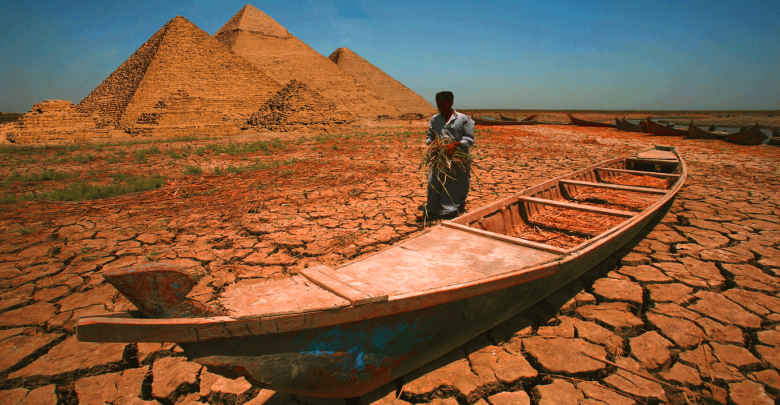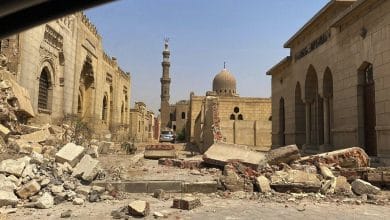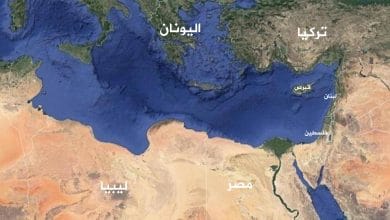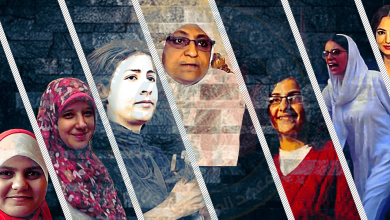
Ethiopian Renaissance Dam & Its implications on Egypt
Construction of the Grand Ethiopian Renaissance Dam and Its implications on Egypt – Crisis Management between Egypt and Ethiopia
The Grand Ethiopian Renaissance Dam (GERD) constitutes a real crisis for the Egyptian regime, where Ethiopia several times blamed Egypt for the failure of negotiations conducted between Sudan, Egypt and Ethiopia on the dam. Also, the Sudanese Foreign Ministry later held the Egyptian side accountable for failure of these negotiations. The fact that there are numerous actors on this issue has complicated the situation, which necessitates that Egypt should seek building alliances and finding lobbying mechanisms to practice pressures on financiers to ensure that Egypt’s quota of water will not be affected.
In fact, Ethiopia exploited Egypt’s preoccupation with the events of the January Revolution (2011); on 2 April 2011, Ethiopian Prime Minister Hailemariam Desalegn laid GERD’s foundation stone and took swift steps to enter into contracts with companies and raising financiers and donors: where in the end, the Italian Saline Impregilo company won the project at a $ 4.5 billion. In coincidence with this activity, there was a great confusion in the Egyptian policies, where the military government at the time did not pay any attention to the likely implications of the dam project.
The biggest problems and threats to Egypt in this case is the desertification of arable land, where estimates and studies refer to desertification of about 2 to 4 million hectares of the current 8 to 10 million hectares of arable land. This will significantly affect the Egyptian economy in general, especially food crops and agricultural workers, and is likely to lead to increasing rural-urban migration, unemployment rates, and prices of the food commodities.
First: Egyptian policy and management of the GERD file
On 23 March 2015, Abdel Fattah al-Sisi signed in Addis Ababa the Declaration of Principles with Ethiopia and Sudan, which is considered an implicit recognition of the construction of the Ethiopian dam. Sisi later paid a series of visits to the Nile Basin countries in attempt to create a counter-decision against the dam construction and prevent expansions in dam projects that the Nile Basin countries were planning to build.
The Egyptian government tried to reactivate the Nile Basin Initiative Agreement (Cooperative Framework Agreement), from which Egypt withdrew in 2010 in protest against the signing of the agreement which is also known as Entebbe Agreement, by six Nile Basin countries (Uganda, Rwanda, Tanzania, Kenya, Burundi and Ethiopia). Sisi on 6 December held a meeting in Cairo with ministers from Sudan, South Sudan, Tanzania, Burundi and Uganda, who were participating in the National Water Research Centre’s conference on water sustainability – in attempt to enhance relations and reactivate cooperation among Nile basin countries. The Cooperative Framework Agreement is an initiative among the Nile basin states that seeks to develop the river in a cooperative manner, share substantial socioeconomic benefits, and promote regional peace and security. The agreement known as the Entebbe Agreement, is meant to replace a 1929 agreement that awarded Egypt and Sudan the majority use of the Nile River.
Also, Sisi and Egyptian officials asked Israel to mediate for resolving the crisis of the GERD construction and try to convince Ethiopia to return to negotiations that were suspended by the Egyptian side ahead of the Egyptian moves in Eritrea in November 2017.
Egyptian Foreign Minister Sameh Shoukry, held 19 rounds of negotiations with Sudan and Ethiopia that did not result in signing any agreements or understandings between the three parties. Negotiations were suspended several times and then resumed in a series of tug-of-war over technical issues, especially those related to the mechanism of filling the dam.
Egypt also practiced pressures on the European Union, China and Russia to stop lending Ethiopia $ 3.7 billion through major diplomatic efforts. However, the EU later approved a large aid budget through a package of programs to be implemented between 2014 and 2020. According to an EU report, the volume of aid reached two billion euros distributed on several programs such as agriculture, food and health. The Egyptian Foreign Ministry also resorted to the World Bank to mediate for resolving the dam crisis.
Also, media reports said that the Egyptian General Intelligence Service provided support to the Ethiopian opposition in Eritrea and also opposition groups within Ethiopia. This support was reportedly in the form of weapons; which led Ethiopia to postpone the visit of its Prime Minister to Egypt several times, especially after seizure of Egyptian weapons that were used by opposition groups. However, the Egyptian authorities denied these reports.
Likeliness of a military solution
The American Stratfor Institute addressed in a report the Egyptian military options to counter construction of the Ethiopian Dam. “While Egypt has struggled to attract diplomatic intervention on its behalf to thwart Ethiopia’s dam construction, tensions have reached the point where Egypt has suggested the use of force to keep the dam from potentially lowering the Nile’s water levels downstream to unacceptable levels … however there are also fairly significant constraints on the physical possibility of an Egyptian military solution,” the Stratfor report read.
Stratfor presented two likely military options to hit the dam while it is under construction. The first is to direct an air strike against the dam, which is difficult due to the political differences with Sudan and Khartoum’s agreements with Ethiopia, taking into consideration that distance is a major obstacle for any Egyptian military option against Ethiopia.
The second option for Egypt, according to Stratfor is to send groups of the Egyptian special operation forces (Thunderbolt), which is also a difficult option as “special operations forces teams would face their own series of obstacles in trying to destroy the dam. Dams are critical infrastructure and routinely protected relatively well in most countries by dedicated military units. Ethiopia would be no exception, especially with all the contention already surrounding the project. So Egyptian special operations forces would need luck and skill to gain access to the dam successfully,” according to the report. In fact, any of the two options “would likely only delay the project, not stop construction”.
The military option against Ethiopia and the Renaissance Dam has great repercussions and is governed by a set of internal and external factors related to any military action in general and in the Horn of Africa in particular. It is also difficult for Egypt to carry out a military operation against Ethiopia amid the rising external debt and security threats in the Sinai Peninsula. Moreover, Sisi lacks any popular support for launching such a war. Instead, Egypt may resort to practicing pressure on neighboring countries to prevent arrival of building materials needed for the construction works and expand presence in Djibouti, the main outlet for the Ethiopian economy, where 80% of Addis Ababa’s trade passes through Djibouti Port, that is surrounded by a set of Chinese, US and French military bases, which represents a major challenge to any military action.
Egyptian companies and banks participate in the construction of the Ethiopian dam
It is ironic that a group of Egyptian banks have invested in the construction of the Grand Ethiopian Renaissance Dam through bonds and shares offered through Ethiopia’s embassies and consulates around the world, according to the Ethiopian government. The move by Ethiopia was to encourage businessmen to invest in the construction of the dam, especially that it offers a 36% interest rate after the World Bank refused to finance the dam. According to the Ethiopian documents, the Egyptian banks are: Bank of Alexandria, Banque du Caire, Citibank, Commercial International Bank, and Arab International Bank.
Also, the conflict in Libya has greatly affected the Egyptian contracting companies, which led some of them to move their activities to the depth of Africa and the Arab Maghreb, making advantage of the Ethiopian government move of allocating $ 100 billion for construction works in December 2013.
Second: Ethiopian policy and management of the Renaissance file
Ethiopia’s foreign policy has witnessed a high level of development and activity since 2010, amid government effort to attract foreign investment in dozens of projects that are likely to achieve a comprehensive development in the country. The projects promoted by Ethiopia abroad are based on the construction of dams for electricity generation and land reclamation in addition to the infrastructure. There are more than 30 dams in Ethiopia, some of which have been finished and others are under construction, as the Ethiopian government targets attracting foreign capital for investment in construction of dams and other projects related to them for achieving development in the electricity, agriculture and trade sectors.
After renewing mandate of Ethiopian Prime Minister Abiy Ahmed in October 2018, he started to restructure the government. As for the Renaissance Dam, Ahmed announced a series of measures against some Ethiopian companies affiliated with the army – associated with the construction of the dam – and cancelled their licenses. The most important thing in this move is that Ahmed announced that construction work has been delayed.
The most important aspect of the new Ethiopian internal scene is the cold conflict between Ethiopian Prime Minister Abiy Ahmed and the military institutions and companies, which directly reflected on the construction of the Grand Ethiopian Renaissance Dam, where Abiy Ahmed declared at a press conference late August 2019 that the GERD might not see light soon. Ahmed said the project was scheduled to be completed in five years but was unable due to the failed administration as well as meddling from the Metal and Engineering Corporation (METEC), a company under the management of the Ethiopian Defense Forces. The Ethiopian prime minister added that the company was also mismanaged due to its board’s lack of experience in managing huge projects. Subsequently, Ahmed revealed that the contract was now being transferred from METEC to a different contractor able to resume and complete the GERD.
As for the Ethiopian foreign policy after the access of Abiy Ahmed to power as prime minister, Ahmed undertook a series of regional moves in the countries of the Horn of Africa in a step to settle problems with neighboring countries. He made a peace agreement with Eritrea after more than 20 years of war between the two countries, that was followed by mutual visits between the two countries. These moves were significant to achieve development in the region by involving neighboring countries such as Djibouti, Eritrea and Sudan in joint development projects. The Ethiopian external relations are based on several main axes, including:
1- Investment of international and regional powers in GERD construction
The international and regional powers that have investments in Ethiopia are the most important actors involved in the GERD construction – such as the United States, China, Israel, the European Union, Saudi Arabia and some other countries. These powers play a major role in the formation and making of Ethiopian decision, as some of these investments have political and security dimensions.
2- Leadership of the Nile basin countries
For several years and amid absence of Egypt, Ethiopia has adopted a policy of encouraging the Nile Basin countries for development under the Cooperative Framework Agreement, known also as Entebbe Agreement, which gave legitimacy to construction of dams and projects – where four countries, Ethiopia, Uganda, Tanzania and Rwanda, signed the agreement in Entebbe in May 2010 amid absence of Egypt; and in February 2011, amidst the events of the Egyptian revolution, Burundi and Kenya signed the agreement. Signed by six Nile Basin countries, the Entebbe Agreement is considered the cornerstone for the international legitimacy of the projects built on the Nile.
3- Security positioning in the heart of the Horn of Africa
Ethiopia plays a major role in the heart of the Horn of Africa to confront the Islamist movements that emerged during the seventies and continued until now; therefore, the Ethiopian government has formed alliances with the United States, the European Union and Israel to confront those movements that have long targeted the interests of these countries. The United States dismantled its military base in South Africa and announced inauguration of its base in Ethiopia through a joint declaration with the Ethiopian government. Ethiopia is effectively present in the confrontation of the Mujahideen Youth Movement in Somalia, Eritrea and Kenya.
Third: The economic and social repercussions of the renaissance of Egypt
The repercussions of the Grand Ethiopian Renaissance Dam crisis on the Egyptian side are not restricted to the political dimension only, but they extend to the economic and social dimensions:
1- The economic dimension
– Egypt’s quota of water declined by 9 to 12 billion cubic meters out of 55 billion cubic meters, about 25 percent, while some experts said it declined by about 20 to 35 billion cubic meters. Decline of Egypt’s water quota by 12 billion cubic meters is considered a major threat to the Egyptian national security.
– The decline of Egypt’s quota of water by 10 billion cubic meters per year costs the agricultural sector losses up to LE 150 billion a year.
– The decline of Lake Nasser water level will affect the work of hydroelectric turbines associated with the High Dam; and it will also affect the Toshka land reclamation project which mainly depend on the lake’s water.
– The loss of only 2% of Egypt’s water quota will cost the country a loss of 200 thousand feddans annually, according to Minister of Irrigation Mohamed Abdel Aati, something which is extremely dangerous. If Egypt lost 15 billion cubic meters on an annual basis, the country will lose 18% of its agricultural land, about one million and 800 thousand feddans out of a total of 10 million feddans.
– Egypt is considered one of the countries that suffers from water deficit estimated at 42% of its needs, and any decline in Egypt’s water quota will be extremely dangerous amid the country’s rising population.
– The decline of Egypt’s quota of water will also affect the electricity production of the High Dam station up to 30% of its total production, according to Eng. Abdul Nabi Abdul-Ghani, Chairman of the Board of Directors of the High Dam Electricity company in an interview in 2013.
– Suspension of the land reclamation projects.
– It will badly affect food industries where the number of food factories exceeds 1200 factories in Egypt.
– It will increase unemployment rate due to the destruction of agricultural land and the suspension of factories.
– It will lead to production reduction of some strategic crops such as rice and sugarcane that need large amounts of water, which will affect Egyptian exports and accordingly increase the trade balance deficit. the Egyptian authorities currently prevent farmers from growing these crops and impose financial fines on those who violate instructions. The Agriculture Ministry reduced the area allowed to grow rice from 1 million and 100,000 feddans to 724 thousand feddans only.
– Increasing prices of basic foodstuffs.
– Decreasing the volume of agricultural and food exports.
– Increasing the volume of food imports, estimated at 60%.
– Affecting the political decision-making due to the increase in food imports.
– Egypt will resort to expensive sea water desalination projects.
– The entry of salt water to the delta due to the low Nile water flow and the high sea level amidst global weather changes.
– Reducing the groundwater level in Upper Egypt.
– Affecting water navigation in the Nile River.
2- The social dimension
– The GERD construction will significantly affect the Egyptian farmers, especially during the time of filling the reservoir.
– Among the consequences of building the Ethiopian dam is that it will lead to expanding the impoverished lower strata and further destroying the middle class, which will lead to increasing internal migration rates and cause major demographic changes in the country.
Conclusion
The current Egyptian regime has committed a major mistake by recognizing the GERD construction in the Declaration of Principles. All the policies it adopted indicate great confusion and lack of strategic vision to address the crisis as well as the relations with the Nile Basin countries in general. Accordingly, Egypt will face major crises that will contribute to accelerating the threats that will face the current regime and the whole State amid destruction of the local agricultural production, especially the essential commodities needed in the Egyptian society.
The crisis that Ethiopia is experiencing in maintaining construction of the dam is a real opportunity for Egypt to make use of. Entering as a partner and payment of the remaining funds necessary to complete the construction works is a great opportunity to impose proper mechanisms for filling the dam’s reservoir, achieve geopolitical gains with the Nile Basin countries next to Ethiopia, and enhance Egypt’s status through real projects. In this way, Egypt can invest in the development of the region and direct Egyptian human resources and youth energies that suffer from unemployment.
The radical changes in the structure of the Ethiopian regime are a good opportunity that should be invested by building links with Muslim-majority Oromo people through civil society associations, as well as establishing strong relations with Ethiopian organizations in the West and creating contacts with thinkers and journalists so that this accumulated work could be an introduction to creation of lobbies that could be utilized in the future.
Read the full study in Arabic here
To Read Text in PDF Format Click here.




Nice article
It’s funny how Egypt still thinks they can control the river Nile when more than 75% of its water originates in the tributaries of Ethiopian highlands. Ethiopia has every right to do what it wants on its share of the river, and the Ethiopian government has assured Egypt that it will not affect their water share.